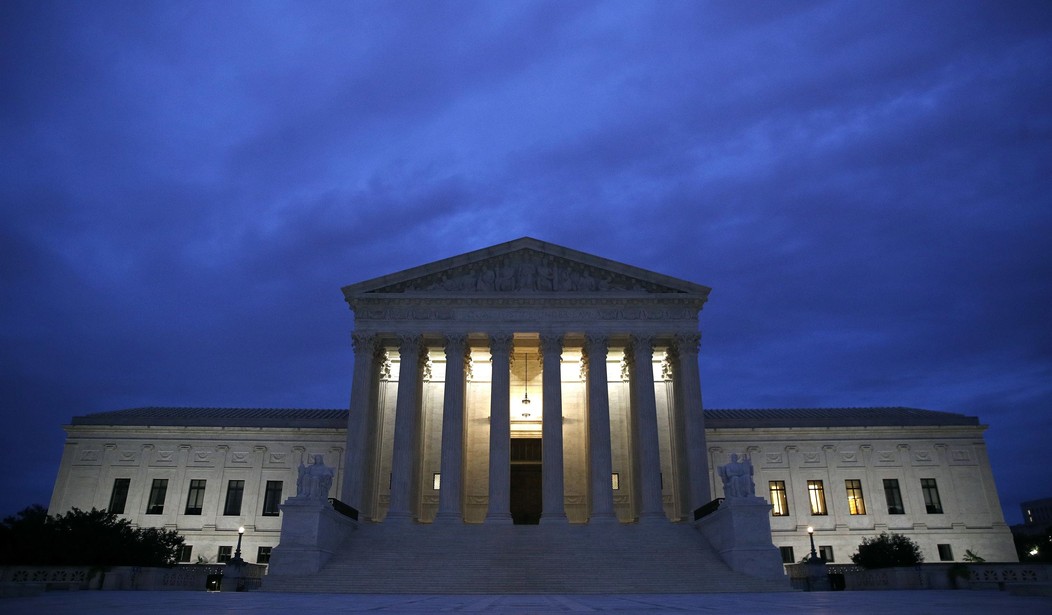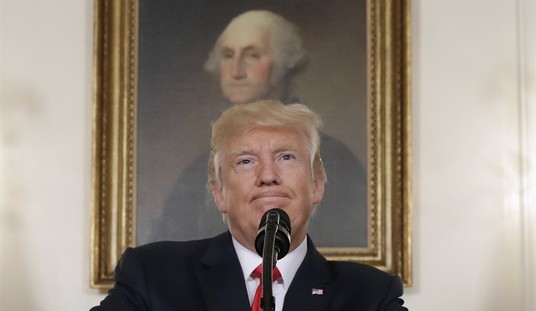They're really building the suspense, aren't they? We're down to the last days of June, and the Supreme Court appears to be holding the weightiest of the weighty decisions for the very end. Of course, we expected as much from the Trump v. USA presidential immunity decision — it was, after all, the very last case argued. But they still have several big ones to go and, until just a bit ago, had only Thursday and Friday noted on the calendar as decision days. Well, not surprisingly, they've now added Monday, July 1, as a decision day, as well. So there will be a handful of decisions on Friday and then the last handful on Monday.
But for Thursday, the court issued its rulings in four cases, which I'm referring to as "The Sleepers" because they've not gotten nearly as much attention as some of the others, but still could have wide-ranging consequences. These were all, of course, split decisions — though not purely along party lines (with one, in fact, being the men vs. the women — assuming you know how to define them). And there was the Idaho abortion decision (actually, non-decision), which accidentally got published to the court's website on Wednesday, so might be a bit anti-climactic, though still has serious ramifications.
OOOPS. Supreme Court Posts Idaho Abortion Decision by Accident
June 27, 2024 Decisions
Date: June 27, 2024
Author: Roberts
Split: 6-3
Dissent: Sotomayor, Kagan, Jackson
Appeal From: Fifth Circuit
Basic Facts:
In the aftermath of the Wall Street Crash of 1929, Congress passed a suite of laws designed to combat securities fraud and increase market transparency. Three such statutes are relevant: The Securities Act of 1933, the Securities Exchange Act of 1934, and the Investment Advisers Act of 1940. These Acts respectively govern the registration of securities, the trading of securities, and the activities of investment advisers. Although each regulates different aspects of the securities markets, their pertinent provisions—collectively referred to by regulators as “the antifraud provisions,” App. to Pet. for Cert. 73a, 202a—target the same basic behavior: misrepresenting or concealing material facts.
To enforce these Acts, Congress created the Securities and Exchange Commission. The SEC may bring an enforcement action in one of two forums. It can file suit in federal court, or it can adjudicate the matter itself. The forum the SEC selects dictates certain aspects of the litigation. In federal court, a jury finds the facts, an Article III judge presides, and the Federal Rules of Evidence and the ordinary rules of discovery govern the litigation. But when the SEC adjudicates the matter in-house, there are no juries. The Commission presides while its Division of Enforcement prosecutes the case. The Commission or its delegee—typically an Administrative Law Judge—also finds facts and decides discovery disputes, and the SEC’s Rules of Practice govern.
One remedy for securities violations is civil penalties. Originally, the SEC could only obtain civil penalties from unregistered investment advisers in federal court. Then, in 2010, Congress passed the Dodd-Frank Wall Street Reform and Consumer Protection Act. The Act authorized the SEC to impose such penalties through its own in-house proceedings.
Shortly after passage of the Dodd-Frank Act, the SEC initiated an enforcement action for civil penalties against investment adviser George Jarkesy, Jr., and his firm, Patriot28, LLC for alleged violations of the “antifraud provisions” contained in the federal securities laws. The SEC opted to adjudicate the matter in-house. As relevant, the final order determined that Jarkesy and Patriot28 had committed securities violations and levied a civil penalty of $300,000. Jarkesy and Patriot28 petitioned for judicial review. The Fifth Circuit vacated the order on the ground that adjudicating the matter in-house violated the defendants’ Seventh Amendment right to a jury trial.
- Whether statutory provisions that empower the Securities and Exchange Commission (SEC) to initiate and adjudicate administrative enforcement proceedings seeking civil penalties violate the Seventh Amendment.
- Whether statutory provisions that authorize the SEC to choose to enforce the securities laws through an agency adjudication instead of filing a district court action violate the nondelegation doctrine.
- Whether Congress violated Article II by granting for-cause removal protection to administrative law judges in agencies whose heads enjoy for-cause removal protection.
Holding: Affirmed and remanded.
When the SEC seeks civil penalties against a defendant for securities fraud, the Seventh Amendment entitles the defendant to a jury trial.
Skinny: If the SEC wants to fine someone for securities fraud, they have to do so via the courts, not just in-house. Or, put another way: "Back off, Congress, back off, Executive Branch, this one's ours."
Note: Some interesting zingers from several of the justices on this one.
- Roberts: "A defendant facing a fraud suit has the right to be tried by a jury of his peers before a neutral adjudicator. Rather than recognize that right, the dissent would permit Congress to concentrate the roles of prosecutor, judge and jury in the hands of the Executive Branch. That is the very opposite of the separation of powers that the Constitution demands."
- Gorsuch: "[The decision] hardly leaves the SEC without ample powers and recourse. The agency is free to pursue all of its charges against Mr. Jarkesy. And it is free to pursue them exactly as it had always done until 2010: In a court, before a judge, and with a jury."
- Sotomayor (in dissent): "Today, for the very first time, this Court holds that Congress violated the Constitution by authorizing a federal agency to adjudicate a statutory right that inheres in the Government in its sovereign capacity, known as a public right."
Confession: I had to look up the Seventh Amendment last night.
In Suits at common law, where the value in controversy shall exceed twenty dollars, the right of trial by jury shall be preserved, and no fact tried by a jury, shall be otherwise re-examined in any Court of the United States, than according to the rules of the common law.
Harrington v. Purdue Pharma, L.P.
Date: June 27, 2024
Author: Gorsuch
Split: 5-4
Dissent: Kavanaugh, Roberts, Sotomayor, Kagan
Appeal From: Second Circuit
Basic Facts:
Between 1999 and 2019, approximately 247,000 people in the United States died from prescription-opioid overdoses. Respondent Purdue Pharma sits at the center of that crisis. Owned and controlled by the Sackler family, Purdue began marketing OxyContin, an opioid prescription pain reliever, in the mid-1990s. After Purdue earned billions of dollars in sales on the drug, in 2007 one of its affiliates pleaded guilty to a federal felony for misbranding OxyContin as a less-addictive, less-abusable alternative to other pain medications. Thousands of lawsuits followed. Fearful that the litigation would eventually impact them directly, the Sacklers initiated a “milking program,” withdrawing from Purdue approximately $11 billion—roughly 75% of the firm’s total assets—over the next decade.
Those withdrawals left Purdue in a significantly weakened financial state. And in 2019, Purdue filed for Chapter 11 bankruptcy. During that process, the Sacklers proposed to return approximately $4.3 billion to Purdue’s bankruptcy estate. In exchange, the Sackers sought a judicial order releasing the family from all opioid-related claims and enjoining victims from bringing such claims against them in the future. The bankruptcy court approved Purdue’s proposed reorganization plan, including its provisions concerning the Sackler discharge. But the district court vacated that decision, holding that nothing in the law authorizes bankruptcy courts to extinguish claims against third parties like the Sacklers, without the claimants’ consent. A divided panel of the Second Circuit reversed the district court and revived the bankruptcy court’s order approving a modified reorganization plan.
Whether the Bankruptcy Code authorizes a court to approve, as part of a plan of reorganization under Chapter 11 of the Bankruptcy Code, a release that extinguishes claims held by nondebtors against nondebtor third parties, without the claimants’ consent.
Holding: Reversed and remanded.
The bankruptcy code does not authorize a release and injunction that, as part of a plan of reorganization under Chapter 11, effectively seek to discharge claims against a nondebtor without the consent of affected claimants.
Skinny: The wealthy pharma family can't protect itself from lawsuits using a bankruptcy case that it's not a party to and in which it's not placing all its assets on the table. The code says what it says and doesn't allow for this.
Note: While Kavanaugh observes in his dissent the practical downside of the decision — "Today's decision is wrong on the law and devastating for more than 100,000 opioid victims and their families" — as the family might no longer be inclined to contribute funds to the bankruptcy estate without the guaranteed protections, Gorsuch, once again, encourages Congress to speak up and do its job if it intends otherwise: "Surely, if Congress had meant to reshape traditional practice so profoundly in the present bankruptcy code, extending to courts the capacious new power the plan proponents claim, one might have expected it to say so expressly somewhere in the code itself."
Ohio v. Environmental Protection Agency (consolidated with Kinder Morgan v. EPA, United States Steel Corporation v. EPA, and American Forest & Paper Association v. EPA)
Date: June 27, 2024
Author: Gorsuch
Split: 5-4
Dissent: Barrett, Sotomayor, Kagan, Jackson
Appeal From: D.C. Circuit
Basic Facts:
The Clean Air Act envisions a collaborative effort between States and the federal government to regulate air quality. When the Environmental Protection Agency sets standards for common air pollutants, States must submit a State Implementation Plan, or SIP, providing for the “implementation, maintenance, and enforcement” of those standards in their jurisdictions. See 42 U. S. C. §7410(a)(1). Because air currents can carry pollution across state borders, States must also design their plans with neighboring States in mind. Under the Act’s “Good Neighbor Provision,” state plans must prohibit emissions “in amounts which will . . . contribute significantly to nonattainment in, or interfere with maintenance by, any other State” of the relevant air-quality standard. §7410(a)(2)(D)(i)(I). Only if a SIP fails to satisfy the “applicable requirements” of the Act may EPA issue a Federal Implementation Plan, or FIP, for the noncompliant State that fails to correct the deficiencies in its SIP. §§7410(k)(3), (c)(1).
In 2015, EPA revised its air-quality standards for ozone, thus triggering a requirement for States to submit new SIPs. Years later, EPA announced its intention to disapprove over 20 SIPs because the agency believed they had failed to address adequately obligations under the Good Neighbor Provision. During the public-comment period for the proposed SIP disapprovals, EPA issued a single proposed FIP to bind all those States. EPA designed its proposed FIP based on which emissions-control measures would maximize cost-effectiveness in improving ozone levels downwind and on the assumption the FIP would apply to all covered States. Commenters warned that the proposed SIP disapprovals were flawed and that a failure to achieve all the SIP disapprovals as EPA envisioned would mean that EPA would need to reassess the measures necessary to maximize cost-effective ozone-level improvements in light of a different set of States. EPA proceeded to issue its final FIP without addressing this concern. Instead, EPA announced that its plan was severable: Should any jurisdiction drop out, the plan would continue to apply unchanged to the remaining jurisdictions. Ongoing litigation over the SIP disapprovals soon vindicated at least some of the commenters’ concerns. Courts stayed 12 of the SIP disapprovals, which meant EPA could not apply its FIP to those States.
A number of the remaining States and industry groups challenged the FIP in the D. C. Circuit. They argued that EPA’s decision to apply the FIP after so many other States had dropped out was “arbitrary” or “capricious,” and they asked the court to stay any effort to enforce the FIP against them while their appeal unfolded. The D. C. Circuit denied relief, and the parties renewed their request in this Court.
- Whether the court should stay the Environmental Protection Agency’s federal emission reductions rule, the Good Neighbor Plan
- Whether the emissions controls imposed by the rule are reasonable regardless of the number of states subject to the rule.
Holding: Applications for stay granted.
The applications for a stay are granted; enforcement of EPA’s rule against the applicants shall be stayed pending the disposition of the applicants’ petition for review in the D. C. Circuit and any petition for writ of certiorari, timely sought.
Skinny: The parties challenging the rule are likely to win in the long run because the EPA didn't properly address concerns raised during the public comment period, so the EPA rule gets put on hold while the challenges work their way through the courts. Or, put another way: Make like a good neighbor and do better, EPA.
Moyle v. United States (consolidated with Idaho v. United States)
Date: June 27, 2024
Author: Per Curiam
Split: 5-4
Dissent: Jackson, Alito, Thomas, Gorsuch
Appeal From: Ninth Circuit
Basic Facts (from Kagan's concurrence):
An Idaho law prohibits abortions unless necessary to prevent a pregnant woman’s death; the law makes no exception for abortions necessary to prevent grave harms to the woman’s health, like the loss of her fertility. Before the law could take effect, the Federal Government sued the State under the Emergency Medical Treatment and Labor Act (EMTALA). That law requires a Medicare-funded hospital to provide essential care to patients experiencing medical emergencies. The Government’s suit contended that EMTALA preempts the Idaho abortion law in a narrow class of cases: when the state law bars a hospital from performing an abortion needed to prevent serious health harms.
The District Court, believing the Government was likely to prevail in its suit, entered a preliminary injunction. During the year that the injunction was in place, women in Idaho were able to obtain abortions in medical emergencies. Idaho meanwhile sought to get the injunction lifted. When the en banc Court of Appeals for the Ninth Circuit declined to stay the injunction, Idaho filed an emergency application here. This Court stayed the injunction and granted the State’s petition for certiorari before judgment. With that stay in effect, Idaho could enforce its abortion ban even when terminating a pregnancy was necessary to prevent grave harm to the woman. The on-the-ground impact was immediate. To ensure appropriate medical care, the State’s largest provider of emergency services had to airlift pregnant women out of Idaho roughly every other week, compared to once in all of the prior year (when the injunction was in effect).
Whether the Supreme Court should stay the order by the U.S. District Court for the District of Idaho enjoining the enforcement of Idaho’s Defense of Life Act, which prohibits abortions unless necessary to save the life of the mother, on the ground that the Emergency Medical Treatment and Labor Act preempts it.
The writs of certiorari before judgment are dismissed as improvidently granted, and the stays entered by the Court on January 5, 2024, are vacated.
Skinny: Punt (for now). Practical effect: Idaho's Defense of Life Act remains on hold while this issue works its way through the courts on the merits.
Note: Reading between the lines, there's a good deal of dissension in the Court, both on the procedural front and on the merits, and a sense that they jumped the gun when they agreed to hear it on an emergency basis. For now, they're sending it back to the lower courts, but as streiff rightly noted in his write-up on it, "We will see this case again."
Added oddities: Another early release of an abortion-related opinion (though this one does appear to have been a clerical error rather than an intentional "leak" and had little practical effect). Also, Justice Jackson's aversion to the use of the term "woman" or "women" is...something.
You can check out prior installments of The Skinny on SCOTUS series, here.
For more up-to-date news on key court cases and legal analysis, please consider upgrading to a VIP account. VIP status will open a plethora of stories and podcasts here at RedState. And remember that a Gold-level account gets you access to all of our sister sites in Townhall Media: PJ Media, Twitchy, Hot Air, Bearing Arms, and Townhall.com. Today, we're running a massive sale: Use promo code USA60 for a 60% discount.















Join the conversation as a VIP Member